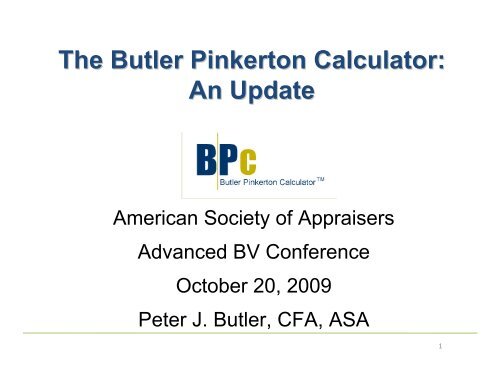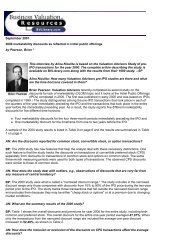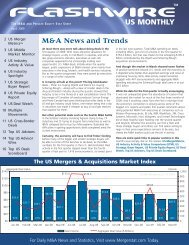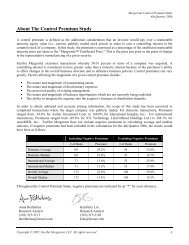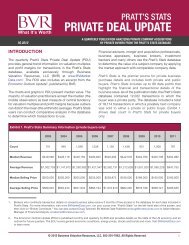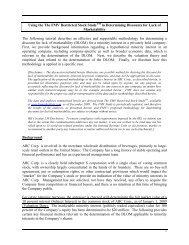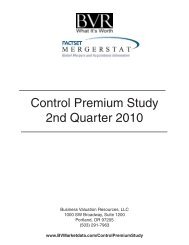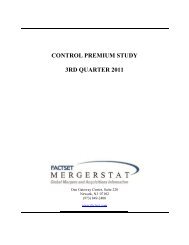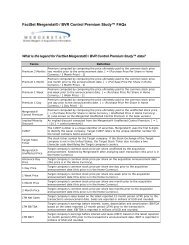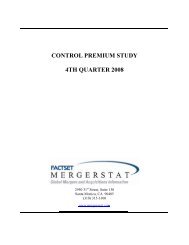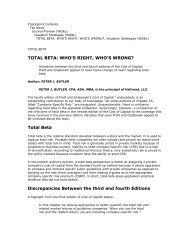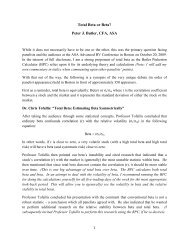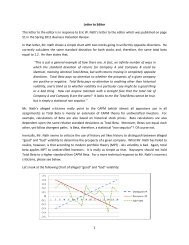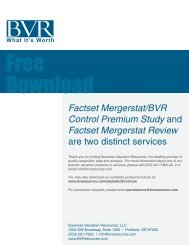The Butler Pinkerton Calculator: An Update - BVMarketData
The Butler Pinkerton Calculator: An Update - BVMarketData
The Butler Pinkerton Calculator: An Update - BVMarketData
You also want an ePaper? Increase the reach of your titles
YUMPU automatically turns print PDFs into web optimized ePapers that Google loves.
<strong>The</strong> <strong>Butler</strong> <strong>Pinkerton</strong> <strong>Calculator</strong>:<br />
<strong>An</strong> <strong>Update</strong><br />
American Society of Appraisers<br />
Advanced BV Conference<br />
October 20, 2009<br />
Peter J. <strong>Butler</strong>, CFA, ASA<br />
1
Learning Objectives:<br />
• Problems with traditional factor models: Use at own<br />
peril!<br />
• <strong>The</strong> Choice: Empirical Data v. No data<br />
– <strong>The</strong> choice is yours:<br />
• Make it wisely<br />
• Impeach inferior cost of capital estimates<br />
• Secondary Choices: Empowerment/Transparency<br />
• Other Applications for the <strong>Calculator</strong><br />
Determination of the proper capitalization rate<br />
presents one of the most difficult problems in<br />
valuation – RR 59-60<br />
2
Let’s Get Some Things Out of the Way First<br />
• You can do all of these calculations yourself.<br />
– You do not need the BPC!<br />
• Total Beta and the BPC violate the CAPM!<br />
– So does every single privately-held company!<br />
– <strong>The</strong> size premium violates the CAPM.<br />
– <strong>The</strong> CSRP violates the CAPM.<br />
– Total Beta and the BPC do not, however, violate financial theory<br />
for individual assets.<br />
• Total Beta assumes a completely undiversified investor (or pool of<br />
completely undiversified investors)<br />
– Good assumption? It depends on the assignment<br />
– Regardless, it is still a data point that is better than guessing<br />
• Not asking you to abandon other cost of capital models, BUT:<br />
3
<strong>The</strong> BUM is Problematic<br />
• Double counting size risk and industry risk?<br />
– Both based on actual returns compared to expected returns<br />
based on beta<br />
• Size risk and CSR risk are next to impossible to separate<br />
– Is a company risky because it is small or is it small because it is<br />
risky?<br />
– Yes and Yes!<br />
• Is there a liquidity premium in the size premium?<br />
– Highly likely<br />
• Is there a liquidity premium in the industry risk premium?<br />
– Likely<br />
• Industry risk premium may include questionable guidelines<br />
• How much different would the data look if another day of the month<br />
had been selected?<br />
• After you get through the gauntlet above; You still have to<br />
completely guess at the CSRP!<br />
4
Traditional Factor Models: Use at Own Peril!<br />
Negative risk factors +/- Numeric Listing<br />
Operating history, volatility of rev & earn. +++ 3.5 X<br />
Lack of management depth ++ 1.0 X<br />
Lack of access to capital resources + 0.5 X<br />
Over reliance on key persons ++ 1.0 X<br />
Lack of size and geographic diversification + 0.5 X<br />
Lack of customer diversification 0.0<br />
Lack of marketing resources + 0.5 X<br />
Lack of purchasing power 0.0<br />
Lack of product/market. dev. resources + 0.5 X<br />
Over reliance on vendors/suppliers 0.0<br />
Limitations on distribution system 0.0<br />
Limitations on fin. reporting/controls + 0.5 X<br />
Positive risk factors<br />
Where is<br />
the<br />
empirical<br />
data?<br />
Long term contracts, unique product 0.0<br />
Patents, copyrights, franchise rights - (1.0) X<br />
Net increase to Cost of Equity 7.0 7.0 7.0<br />
5
<strong>The</strong> Problem: What Do the Courts Want?<br />
• Gesoff v. IIC Industries<br />
– “This court has also explained that we have been<br />
understandably . . . suspicious of expert<br />
valuations offered at trial that incorporate<br />
subjective measures of company-specific risk<br />
premia, as subjective measures may easily be<br />
employed as a means to smuggle improper<br />
risk assumptions into the discount rate so as<br />
to affect dramatically the expert’s ultimate<br />
opinion on value.”<br />
6
<strong>The</strong> Courts Want Empirical Data!<br />
• Delaware Open MRI Radiology Associates<br />
v. Howard B. Kessler, et al<br />
– “To judges, the company specific risk<br />
premium often seems like the device<br />
experts employ to bring their final<br />
results into line with their clients’<br />
objectives, when other valuation<br />
inputs fail to do the trick.”<br />
7
Summary of Factor Models<br />
• Excellent models to understand Size:CSR<br />
• But, do not provide what the courts want:<br />
– Empirical data on Total Risk and/or CSR<br />
• If you want to make enemies, try to change<br />
something.<br />
Woodrow Wilson, 28 th President of the United States<br />
8
<strong>The</strong> Solution: Total Beta and the BPC<br />
Solving for the only unknown in the two equations, CSRP:<br />
• TCOE = R f + Tβ*ERP = R f + β*ERP + SP + CSRP<br />
Professors of<br />
Finance and<br />
Economics<br />
Damodaran<br />
Well–known appraisers<br />
CAPM<br />
Modified CAPM<br />
Risk Allocation:<br />
• Combined Size:CSRP = (Tβ–β)*ERP<br />
• CSRP = (Tβ–β)*ERP – SP<br />
BPC<br />
“Market approach twist to developing a discount rate.”<br />
9
<strong>The</strong> <strong>Calculator</strong> is:<br />
1) Empirical,<br />
2) Transparent,<br />
3) Real-time (or as close as possible),<br />
4) <strong>The</strong> only source (that appraisers typically<br />
rely upon) that captures total risk, and<br />
5) Empowering<br />
12
More Transparency<br />
13
Practical Advice<br />
• This is clearly a great addition to what we<br />
have done in the past. We used to use<br />
Cost of Capital Quarterly to get an idea of<br />
the cost of equity by SIC code. We would<br />
adjust from there. Now, instead of using<br />
the entire industry, we can choose<br />
better guideline data as a starting point.<br />
– Gary Trugman, CPA/ABV, MCBA,<br />
ASA<br />
14
Impeach Inferior Estimates of Cost of Capital<br />
Build-Up Method:SIC Code 8742<br />
(Management Consulting Services, but really interested in litigation<br />
consulting)<br />
• ACCESS WORLDWIDE CMMNCTNS<br />
• ADVISORY BOARD CO<br />
• AON CORP<br />
• BEARINGPOINT INC<br />
• BUTLER NATIONAL CORP<br />
• CIRTRAN CORP<br />
• COMFORCE CORP<br />
• CORPORATE EXECUTIVE BRD CO<br />
• CROSS COUNTRY HEALTHCARE INC<br />
• DIAMOND MANAGEMENT & TECHNL<br />
• ELOYALTY CORP<br />
• EMCOR GROUP INC<br />
• EXPONENT INC<br />
• FTI CONSULTING INC<br />
• GARTNER INC<br />
• HALLWOOD GROUP INC<br />
• HEWITT ASSOCIATES INC<br />
• HURON CONSULTING GROUP INC<br />
• INVENTIV HEALTH INC<br />
• LECG CORP<br />
• MANAGEMENT NETWORK GROUP INC<br />
• MAXIMUS INC<br />
• NAVIGANT CONSULTING INC<br />
• OCEANIC EXPLORATION CO<br />
• PAREXEL INTERNATIONAL CORP<br />
• PDI INC<br />
• PHC INC/MA -CL A<br />
• QUANTUM GROUP INC<br />
• RAHAXI INC<br />
• REHABCARE GROUP INC<br />
• SOUTHWEST CASINO CORP<br />
• SPHERIX INC<br />
• SUNRISE SENIOR LIVING INC<br />
• TALEO CORP<br />
• TETRA TECH INC<br />
• THOMAS GROUP INC<br />
• TRI-ISTHMUS GROUP INC<br />
• TURNAROUND PARTNERS INC<br />
• TYSON FOODS INC -CL A<br />
• UNITEDHEALTH GROUP INC<br />
• VERSAR INC<br />
• WATSON WYATT WORLDWIDE INC<br />
15
<strong>The</strong> “Battle of the Experts” is Over Before it Even Began<br />
Total Cost of Equity (TCOE)<br />
Litigation Consulting Firms<br />
More defensible<br />
18.50%<br />
18.00%<br />
17.50%<br />
Empirical data<br />
BPC<br />
BPC<br />
17.00%<br />
16.50%<br />
16.00%<br />
15.50%<br />
BPC<br />
BPC<br />
BUM<br />
Out of<br />
thin air<br />
15.00%<br />
Guess<br />
14.50%<br />
14.00%<br />
FCN ($2.7B) HURN ($1.0B) NCI ($600M) CRAI ($265M) Subject ($?)<br />
Subject: risk-free=4.16% (5/18/09); ERP = 6.5%; BUM = build-up method: IRP = -1.46%; SP = 5.81%; CSRP = 0.5% (Guess);<br />
BPC = <strong>Butler</strong> <strong>Pinkerton</strong> <strong>Calculator</strong>: 5-year-lookback; Market proxy = S&P 500<br />
16
Interesting Observation: “I Don’t Have<br />
any Good Guidelines!”<br />
• BUM with an IRP: You already have assumed<br />
“good” guidelines – at least for systematic risk.<br />
– Use BPC to impeach inferior estimates of the<br />
cost of capital<br />
• Broaden your search: Guidelines = guidance<br />
– Joyce C. Hall v. Commissioner:<br />
• Hallmark Cards v. MCD, BUD, IBM, KO,<br />
AVP<br />
• Many small publicly-traded companies.<br />
• Company-specific risk is just that – company<br />
specific.<br />
17
Practical Advice Related to Guidelines<br />
• Frankly, it was this analysis (reviewing Forms 10-K, etc.)<br />
that gave me the best insight into the characteristics<br />
that affect risk in this industry. I don’t believe that you<br />
can reasonably assess company specific risk factors<br />
without an understanding and analysis of the<br />
benchmarks derived from the BPC.<br />
• I much prefer BPC because it forces me to examine<br />
public company data about industry risk factors and value<br />
drivers which is available through public filings, press<br />
releases, analyst reports, etc. <strong>The</strong> data is much more<br />
comprehensive in nature than the limited data<br />
available for private companies.<br />
– James M. Skorheim, JD, CPA/ABV/CFF, CFE, CVA,<br />
CrFA<br />
18
Other BPC Applications:<br />
• First, we do a significant amount of Fair Value compliance<br />
work, and the BPC is a great tool for developing capital<br />
costs for hypothetical market participants. We've had<br />
general acceptance of this method in audit review, and it's<br />
a great time saver.<br />
• Second, in documenting a decision regarding discounts for<br />
lack of marketability, we regularly use QMDM as one of the<br />
methods considered. <strong>The</strong> BPC enables us to develop<br />
actual market equity returns for smaller publicly traded<br />
companies, providing a lower limit for the expected return<br />
input in QMDM.<br />
– James B. Lurie, CPA/ABV, ASA, CBA, CVA, BVAL, CIRA<br />
19
Other BPC Applications (continued):<br />
• In using the market approach, the market multiples can be adjusted not<br />
only for size and growth, but also for the CSRP. Again, the judgment gap<br />
is narrowed. Finally, I have found that the variance between the values<br />
determined by the income and GPTC methods has been significantly<br />
reduced.<br />
– Donald P. Wisehart, ASA, CPA/ABV/CFF, CVA, MST<br />
• <strong>The</strong>re is a reason why your method (BPC) and our method (used to adjust<br />
public company multiples for CSR) are similar, that’s because both are<br />
actually the same method, developed a long time ago.<br />
– Vicentiu M. Covrig, Ph.D., CFA in an e-mail to <strong>Butler</strong><br />
<strong>The</strong>re is nothing more difficult to take in hand, more perilous to conduct,<br />
or more uncertain in its success, than to take the lead in the introduction<br />
of a new order of things.<br />
– Niccolo Machiavelli, Italian philosopher<br />
20
Other BPC Applications (continued): 123R<br />
21
Other BPC Applications (continued): In Search of the “True” Beta<br />
Beta Source Market Proxy Period Frequency Adjustment<br />
1 Bloomberg Over 20 domestic series Adjustable Adjustable (0.67*OLS Beta)+(0.33*1.0)<br />
2 Compustat S&P 500 5 years Monthly None<br />
3 Ibbotson S&P 500 5 years Monthly Adjusted toward peer group beta<br />
weighted by stat. significance<br />
4 Value Line NYSE Composite 5 years Weekly 0.35+0.67*OLS Beta<br />
5 Yahoo!Finance S&P 500 3 years Monthly None<br />
6 BPC 6 domestic series Adjustable Weekly - default None<br />
Adjustable - manual<br />
BPC rank 2nd Tied first 2nd Debatable<br />
Sources: Table 6-11, SBBI Valuation Yearbook and definitions from Yahoo!Finance.<br />
22
Total Beta:BPC and Peer Review<br />
1) Referenced in AICPA textbook<br />
written by G. Trugman,<br />
Understanding Business<br />
Valuation;<br />
2) Referenced in PPC’s 19 th<br />
<strong>An</strong>nual Guide to Business<br />
Valuations;<br />
3) Referenced in CCH’s Business<br />
Valuation Guide;<br />
4) E-book in collaboration with<br />
Morningstar;<br />
5) Current <strong>Update</strong> in<br />
Valuations/part of training<br />
material for NACVA;<br />
6) Part of HBS Case Study;<br />
7) Numerous independent<br />
endorsements and<br />
testimonials;<br />
8) Can be proven with the Sharpe<br />
ratio. It is just CAPM theory<br />
for the undiversified investor;<br />
9) Academic support;<br />
10) More than 10 articles;<br />
11) Numerous presentations;<br />
12) Cost of Capital, 3 rd edition<br />
23
Independent Select Testimonial<br />
• Total beta is a widely accepted measure of<br />
risk in situations where investors are not<br />
well diversified. <strong>The</strong> <strong>Butler</strong>-<strong>Pinkerton</strong><br />
<strong>Calculator</strong> is a convenient and flexible<br />
tool for quickly arriving at an objective<br />
estimate of total beta and the company<br />
specific risk premium for a privately held<br />
company.<br />
– Keith Harvey, Ph.D., CFA (A finance professor<br />
made aware of Mr. Kasper’s allegations)<br />
24
<strong>An</strong>other Select Testimonial<br />
• We believe that the <strong>Butler</strong>-<strong>Pinkerton</strong> <strong>Calculator</strong><br />
is a useful tool for appraisers who want a<br />
quantitative way to assess the maximum<br />
CSRP. What the Total Beta and calculator<br />
computes is the maximum or upper bound for<br />
the CSRP. A good appraisal should also use<br />
subjective techniques and judgment to<br />
determine the appropriate CSRP for the<br />
subject company.<br />
– Vicentiu M. Covrig, Ph.D., CFA and Daniel<br />
McConaughy, ASA, Ph.D. (Finance professors made<br />
aware of Mr. Kasper’s allegations)<br />
25
Total Beta and <strong>The</strong> BPC: Why Not Now?<br />
• Subjective Factor Models Provide NO empirical data for<br />
Total Risk or CSRP!<br />
– <strong>An</strong>y other source is subject to harsh criticism<br />
– BPC is not a solution in search of a problem<br />
• BPC provides (moderately subjective) EMPIRICAL data:<br />
– Defend/support all assumptions/inputs<br />
• No different than any other cost of capital input<br />
– Except the BPC provides real-time, transparency for<br />
specific guidelines<br />
– Except the BPC empowers you to observe the<br />
sensitivities in the calculations<br />
26
Questions to Consider:<br />
• If Total Beta and the BPC (which empirically<br />
capture total risk) were developed first, would<br />
you abandon them to rely upon other databases<br />
(which only capture partial risk)?<br />
• If Total Beta and the BPC were developed first,<br />
would you abandon them to rely upon the purely<br />
subjective factor models (which require a<br />
complete guess for a CSRP)?<br />
– One thing we do recognize is that the valuation profession can use<br />
more tools grounded in market observations to help develop discount<br />
rates – Roger Grabowski; BV <strong>Update</strong> - November 2006<br />
• Note: <strong>The</strong> BPC was commercialized in November 2007<br />
27
Questions<br />
<strong>An</strong> important scientific innovation rarely makes its way rapidly winning over<br />
and converting its opponents; it rarely happens that Saul becomes Paul.<br />
What does happen is that its opponents gradually die out and the growing<br />
generation is familiarized with the idea from the beginning.<br />
– Max Planck, German physicist, founder of quantum theory<br />
28
<strong>The</strong> <strong>Butler</strong> <strong>Pinkerton</strong> <strong>Calculator</strong>:<br />
<strong>An</strong> <strong>Update</strong> and A Response<br />
American Society of Appraisers<br />
Advanced ASA BV Conference<br />
October 20, 2009<br />
Peter J. <strong>Butler</strong>, CFA, ASA<br />
Never let the search for the perfect get in the way of the perfectly good<br />
- John Elson, Time editor<br />
29
Whose Misunderstanding of Financial <strong>The</strong>ory<br />
is the Question<br />
• “We have argued that in equilibrium there will be a simple<br />
linear relationship between the expected return and standard<br />
deviation of return for efficient combinations of risky assets.<br />
Thus far nothing has been said about such a relationship for<br />
individual assets. Typically the ER, σR values associated with<br />
single assets will lie above the capital market line, reflecting the<br />
inefficiency of undiversified holdings. Moreover, such points may be<br />
scattered throughout the feasible region, with no consistent<br />
relationship between their expected return and total risk (σR).<br />
However, there will be a consistent relationship between their<br />
expected returns and what might best be called systematic risk, as<br />
we will now show.”<br />
Portfolio risk<br />
William F. Sharpe (1964), “Capital asset prices: A theory of market<br />
equilibrium under conditions of risk,” Journal of Finance, 19 (3), p.436.<br />
A<br />
Portfolio<br />
30
Are You on the Left-side or the “Right”-side?<br />
• Correlated relative volatility v. Relative volatility<br />
• Covariance v. Standard deviation<br />
• Well-diversified portfolio v. Stand-alone asset<br />
• Portfolio managers v. Appraisers<br />
• Partial risk v. Total risk<br />
• NO empirical data v. Empirical data<br />
• A few appraisers v. Ph.Ds and a growing<br />
number of appraisers<br />
• It’s your choice – I have made mine.<br />
31
Conclusion from Mr. Kasper’s Paper<br />
• “Until the authors provide empirical evidence<br />
that total beta produces better estimates of<br />
actual public company returns…”<br />
– Why would we?<br />
– Mentioned in very first article that the<br />
technique does not do this – Mr. Kasper<br />
missed it!<br />
– CSR is at least partially diversified away for<br />
publicly-held stocks.<br />
• CSR, however, is priced for PRIVATE<br />
companies<br />
• Use Total Beta as a proxy for PRIVATE<br />
companies<br />
32
Other Observations: Instability of Beta<br />
Dnacq Healthcare (DYII)<br />
Dryships (DRYS)<br />
Beta Total Beta Beta Total Beta<br />
Jan-08<br />
Nov-08<br />
Monday 0.34 10.72 Monday 2.88 4.33<br />
Tuesday 1.18 11.60 Tuesday 2.52 4.70<br />
Wednesday 0.60 12.05 Wednesday 2.41 4.39<br />
Thursday 0.60 12.93 Thursday 2.31 4.25<br />
Friday -0.47 11.92 Friday 2.18 3.93<br />
Mean 0.45 11.84 Mean 2.46 4.32<br />
Median 0.60 11.92 Median 2.41 4.33<br />
SD 0.60 0.80 SD 0.27 0.28<br />
CV 1.33 0.07 CV 0.11 0.06<br />
33
Other Findings (continued):<br />
• Statistical errors with beta (instability of beta) (continued)…<br />
– Total beta (TCOE-side of <strong>Calculator</strong>) is relatively immune<br />
– BPC uses OLS beta to keep the following intact:<br />
• Other commercial sources use OLS regression<br />
– Recommendations: Calculations are very quick and easy<br />
• Look at all 5 days of the trading week<br />
• Look at different look-back periods<br />
• T-stat greater than 80% (or whatever you so choose)<br />
• Select an appropriate R-square as a hurdle<br />
• Question: Maybe a low R-square captures exactly what it should<br />
be capturing – a stock with low systematic risk?<br />
34
Response to Roger Grabowski’s Slides<br />
• Which is it?<br />
– “<strong>The</strong> cost of capital should reflect the risk of<br />
the investment, not the cost of funds to the<br />
investor”.<br />
– “Risk of an investment and its FMV must be<br />
developed based on the risks (and pricing)<br />
perceived by investors that comprise the pool<br />
of likely buyers for the subject asset…”<br />
• “No one (researchers) uses TCOE = R f +<br />
TB*RP m ”<br />
– Why would an academic use TCOE?<br />
– TCOE is not priced in the public markets<br />
35
Response to Roger Grabowski’s Slides<br />
• “CSRP estimates derived from beta estimates are subject to<br />
estimation error (i.e., CSRP estimates are unreliable)”<br />
– True; Use all five days of the trading week<br />
– Duff & Phelps’ data, dependent upon sum beta, is also subject to<br />
estimation error<br />
• How would Duff & Phelps or Morningstar’s data look if<br />
another day of the month was used?<br />
– No one knows. <strong>The</strong> databases are not transparent.<br />
– What is not subject to estimation error? This is valuation!<br />
• “<strong>The</strong> Sharpe Ratio does not cover cases in which one investment<br />
return is involved”<br />
– Other than in private company valuation there are no individual<br />
investments.<br />
– Stocks are part of portfolios<br />
36
Summary:<br />
• All models are wrong, but some are useful.<br />
George Box, statistician<br />
– Total beta and the BPC are very useful.<br />
– You can use them (or perform the calculations yourself)<br />
and be subject to Mr. Kasper’s alleged criticisms or be<br />
subject to harsh criticisms from the Court.<br />
• Your Choice!<br />
• It takes a model to beat a model.<br />
Milton Friedman, Nobel Prize winning economist<br />
– Total beta and/or the BPC have beaten other<br />
models/databases that require a complete guess for<br />
CSRP:<br />
1) <strong>An</strong>d do not empirically capture total risk and<br />
2) Are not transparent and empowering<br />
37


